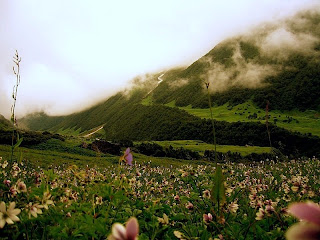Valley of Flowers National Park
Valley of Flowers National Park is an Indian national park, located at a height in West Himalaya. The valley is enriched with thousands of different species of flowers, flora and also home to rare and endangered animals, including the Asiatic Black Bear, Snow Leopard, Brown Bear and blue sheep. The Valley zone lies between the mountain ranges of the zanskar and Great Himalayas.
State: Uttarakhand, India
District: chamoli
Nearest town: Joshimath
Location: The Valley of Flowers is nestled in the upper expanses of Bhyundar Ganga near Joshimath in Gharwal region.
The Valley is 20 km northwest of Nanda Devi National Park across the wide valley of the Bhyundar Ganga. It is one of two hanging valleys lying at the head of the Bhyundar valley, the other being the shorter Hemkund valley which runs parallel some 10 km south. It runs east-west approximately 15 km by an average of 6 km wide, in the basin of the Pushpawati river, a small tributary flowing from the Tipra glacier which descends from Gauri Parbat in the east.
Road Route from Delhi: Delhi – Meerut – Haridwar – Rishikesh – Rudraprayag – Joshimath – GovindGhat – Trekking (17 kms) – Valley of Flowers..
By Air: Jolly Grant Airport is the nearest Airport to Valley of Flowers but the roads are only connected upto Govind Ghat from where you have to commence trek of 16kms to reach Valley of Flowers.
By Rail: The nearest railway station to Valley of flowers is Rishikesh but the roads are only connected upto Govind Ghat from where you have to commence trek of 16 kms to reach Valley of Flowers
Best time to visit : From mid April to June temperatures are moderate to cool (19°C maximum). . The Valley of Flowers also has the microclimate of an enclosed inner Himalayan valley, and is shielded from the full impact of the southwest summer monsoon by the Greater Himalaya range to its south. There is often dense fog and rain especially during the late summer monsoon. Both Basin and Valley are usually snow-bound for six to seven months between late October and late March, the snow accumulating deeper and at lower altitudes on the shadowed southern than on the northern side of the valleys..










No comments:
Post a Comment